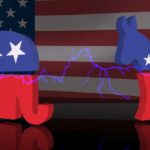August 2020
Thank you for being so vulnerable.
I bristle at the words. I’m not sure why. I am pro-vulnerability, pro-emotion. I’m not cold or clinical or distant. Not at work, not ever. What I feel, I show: happiness, silliness, sadness, disappointment.
As a principal, I was a crier. In fact, on high school graduation day, my faculty took bets on how long I would last before crying. Many were impressed that I made it more than one minute (one minute, 43 seconds, thank you very much).
I know that privilege plays a role in my free-flowing emotionality. My whiteness and my maleness leave me comfortable at work: comfortable to crack jokes, to air grievances, to weigh shortcomings, to weep. To live easily and publicly in my feelings with minimal risk or fear.
I’m fearless, too, because I am my mother’s son. She was so open, so engaged, about feelings. Expressing was good, bottling was bad. In our little home, naming the day’s feelings and parsing their causes came along with setting the table.
My father was different. He was reserved. He struggled to find the words for how he felt, or at least, to share them. I suspected, somewhere deep in him, a sensitive core. But whatever softness lurked there was caked beneath a veneer of Irish-Catholic, mid-Twentieth-century manhood.
As a kid, I saw my father every other weekend; less so as I grew older. At this cadence, his stoicism failed to shape me. I was not around it enough to absorb or emulate it. Instead, his masculine restraint served as a kind of foil for my mother’s warmth. I understood, preferred, and grew into her emotive ways.
And there were the years of child therapy following the divorce. From age three, I played and shared weekly in the care of a wonderful therapist, Dr. Squillace. Mom called her “the talk doctor.” Talk Doctor was so normalized, for me, that I was surprised – and sad – when I learned at age 8 that not every kid had one.
Perhaps this – my emotive, talk-y childhood – is why I bristle at Brene-Brown era vulnerability. Why I pause at the mood meters and the circles. Why I, in private, worry that something is off about the way we educators are thinking aboutsocial-emotional learning.
Don’t mistake me: I believe, fiercely, that schooling is as social and emotional as it is academic. I believe that schools should facilitate children’s social and emotional and intellectual development. By extension and by necessity, I believe that teams of educators must engage themselves on social and emotional and intellectual levels.
Still, there are elements of the current SEL landscape that don’t sit right with me. My critiques are nascent, fledgling. But I do notice, and I do worry, about a few things.
Worry 1: performativity. To me, any of the highly routinized approaches to SEL seem too structured to be real – or to be really real. Phrases like “thank you for being so vulnerable”become easy, familiar, impersonal. Such phrases quickly become a weird kind of cultural capital. They become words that we know to say, words that signal that we have read the right things, have listened to the right podcasts. That we are trending in the right direction. Phrases that garner applause and snaps and ^^^^ in the Zoom chat. These interactions can be genuine; but they can also be evasive, obscuring, and at worst, self-promoting and manipulative.
Worry 2: purpose. I find that people often describe SEL curricula in terms of their inputs – the activities, models, and routines – rather than the specific desired outcomes. When discussions do gesture toward purpose, they can be troublesome. For example, is emotional literacy all about helping students to focus – or to (re)focus – during class? Are feelings just obstacles to academic productivity, things we are meant to overcome? Is SEL where we learn how to transform our “bad” feelings – the reds or the blues – into “good” feelings – the greens and the yellows?
Certainly, self-regulation is an important skill. But it’s also complicated. Speaking for myself, I’ve come to recognize, in my mid-thirties, that I tend to overwork and over-interpret my emotions in ways that are exhausting and unhealthy. My best friend recently shared some wisdom from her therapist: Feelings have no master. I was shocked by how shocking this idea felt to me. My feelings are not for controlling, Instead, perhaps, they are for … feeling. Is that what SEL should work towards – feelings awareness, rather than feelings management? If both, in what proportion? We would do well to think more deeply and specifically about the purpose of SEL curricula in schools: what it really means to be learned in one’s emotions, and what that might mean for our work with children and with one another.
Worry 3: paternalism. Like so many aspects of schooling and educational innovation in particular, SEL seems off to the races – programs are popping up and rolling out with fervor. There is that classic urgency, the sense that if your school is not posting meters or hosting circles, you’re behind the times. For sure, there is value in adopting these off-the-shelf programs. Since (some parts of) academic curricula are visible, tangible, and time-bound, it can be useful and important for SEL curricula to adopt parallel forms. Units, toolkits, and schedule blocs are practical. They ascribe an explicit value to SEL that has been wanting in too many schools for too long.
At the same time, such programming tends to be top-down. I worry that family dialogue and engagement have not been central to many SEL adoption plans. Do we understand what families do – and do not – expect and want of schools when it comes to SEL? How do we think about the myriad ways that different cultures and individuals might process and express their emotions? What preferences might kids and adults have for the role of feelings in the classroom and at work, and to what degree ought we honor those preferences? These questions are particularly important given that some of the most popular ideas and programs are white-authored and white-led, prone to replicating white-centric and white dominant modes of social-emotional “literacy.”
Those are some of my worries. Again, they are nascent, in flux. Like everything we do, SEL is terribly complicated. I know that my reaction to today’s SEL is my own. I bring a lot of myself to SEL. In particular, I bring my privilege; the comfort and ease with which I have been able to express my emotions at work, sans structure; and I bring my childhood; the family circumstances that led me to be well-practiced in emotional expression.
But I think it’s important, always, for us as educators and as people to share our noticings, our wonderings, our hopes and our fears. I’m glad that our field is embracing the social and emotional dimension of schooling. My hope is for the authentic. As we do so, my fear is of the proscriptive.
Today at school, if someone thanks me for being vulnerable, I know that they have read Brene. But I don’t know that they have really listened to and heard me, as me, on my own terms. Similarly, if a student says they are feeling green, I know they understand the mood meter. But I don’t yet know that there is, between us, the kind of trust that will move our conversation beyond the tool and the color – and into the real space between us.
And so, I do worry. I worry that too much SEL programming will program the humanity out of our feelings and our relationships. Not entirely – I trust educators too much for that to happen. But enough to raise important questions, and to spark significant conversations, about the what, why, how, and who of our burgeoning SEL movement – which is an important, but vulnerable, endeavor.



